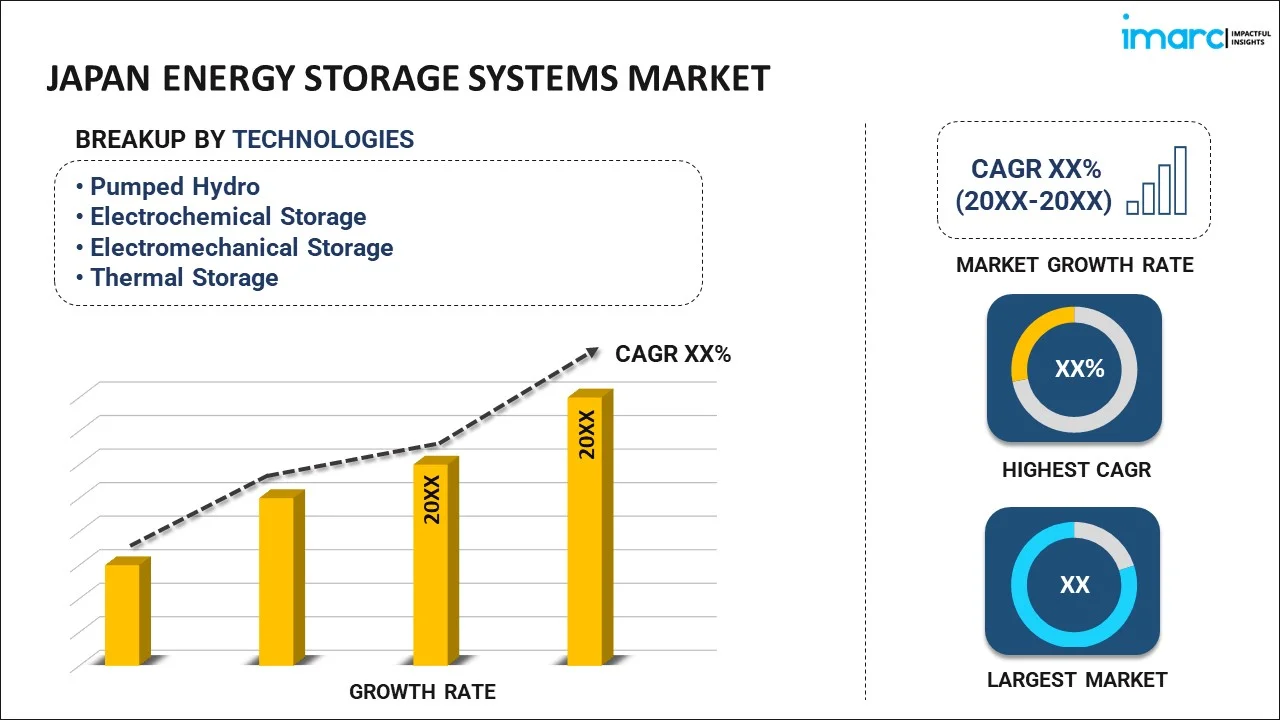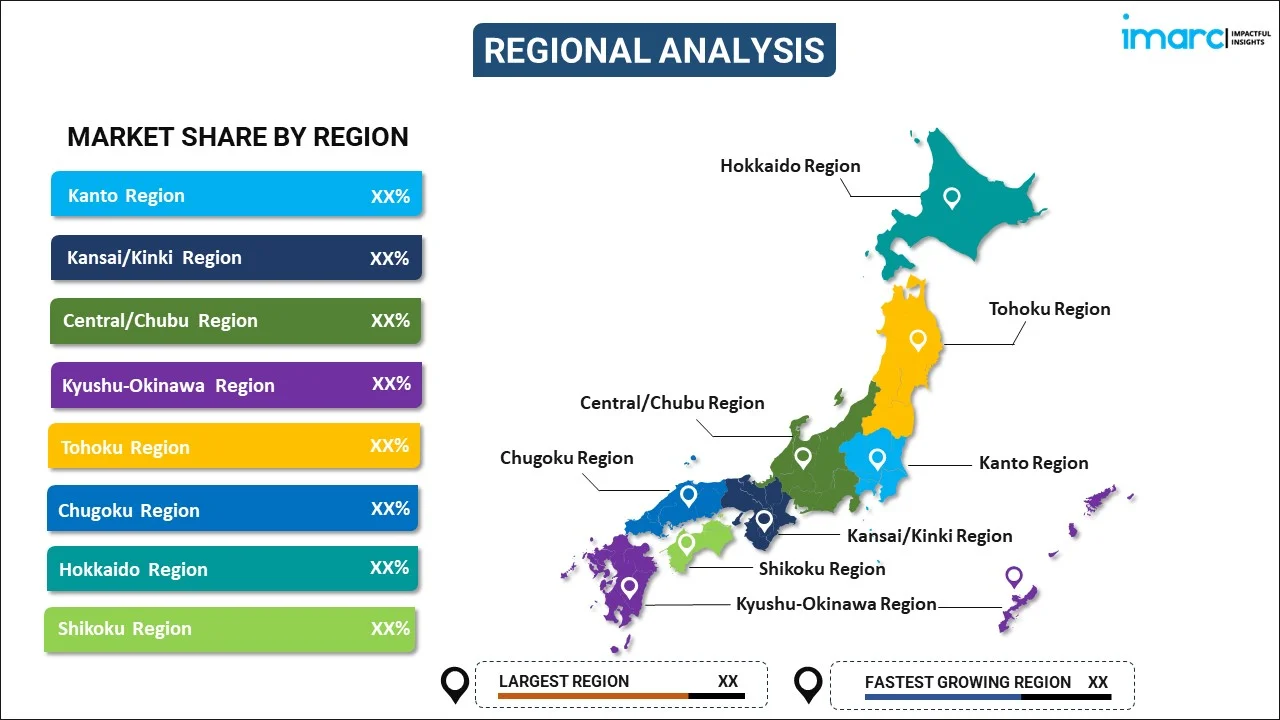
Japan Energy Storage Systems Market Report by Technology (Pumped Hydro, Electrochemical Storage, Electromechanical Storage, Thermal Storage), Application (Stationary, Transportation), End User (Residential, Non-Residential, Utilities), and Region 2025-2033
Market Overview:
Japan energy storage systems market size reached 15.1 GW in 2024. Looking forward, IMARC Group expects the market to reach 29.4 GW by 2033, exhibiting a growth rate (CAGR) of 7.32% during 2025-2033. The market is being propelled by several significant factors, including the heightened need for electricity during emergency power outages, the growing adoption of renewable energy sources, and global efforts to mitigate harmful emissions.
|
Report Attribute
|
Key Statistics
|
|---|---|
|
Base Year
|
2024 |
|
Forecast Years
|
2025-2033 |
|
Historical Years
|
2019-2024
|
| Market Size in 2024 | 15.1 GW |
| Market Forecast in 2033 | 29.4 GW |
| Market Growth Rate (2025-2033) | 7.32% |
Energy storage systems (ESS) are devices engineered to capture and store various forms of energy, including chemical, kinetic, gravitational potential, latent heat, radiation, and thermal energy. Subsequently, they can convert this stored energy into electricity for future usage. ESS relies on diverse technologies, encompassing pumped hydro, electrochemical, electromechanical, and thermal storage methods. They play a crucial role in all aspects of the energy cycle, including generation, transmission, distribution, and consumption. One of their significant advantages is cost-effectiveness, offering robust energy infrastructure and aiding in the seamless integration of renewable and clean energy sources. Energy storage systems act as a form of insurance during power outages, mitigating potential losses and reducing downtime. Furthermore, they have the potential to lower electricity demand, enhance overall efficiency, and reduce greenhouse gas (GHG) emissions. Consequently, their applications span residential, non-residential, and utility sectors throughout Japan.
Japan Energy Storage Systems Market Trends:
The energy storage systems market in Japan is experiencing robust growth, driven by various compelling factors. Notably, the increasing need for ESS to address peak demand periods is a significant driver, ensuring a reliable power supply during high load periods. Additionally, the surge in electric vehicle (EV) development is boosting the demand for energy storage systems within the automotive industry, presenting positive prospects for the market. Another crucial factor contributing to market growth is the growing requirement for uninterrupted electricity supply during emergency power outages, preventing disruptions in productivity. This aligns with the increasing demand for sustainable and energy-efficient solutions, further fueling the expansion of the regional market. Furthermore, heightened consumer awareness regarding rising greenhouse gas (GHG) emissions is creating lucrative growth opportunities for industry investors. Government agencies in various countries are actively promoting energy storage systems adoption to encourage the utilization of renewable energy sources, exerting a positive influence on the market's trajectory. Moreover, the increasing deployment of grid stability ESS projects and the growing adoption of advanced thermal energy storage (TES) systems in buildings are strengthening market growth in Japan. These factors are projected to fuel the market growth in Japan in the coming years.
Japan Energy Storage Systems Market Segmentation:
IMARC Group provides an analysis of the key trends in each segment of the market, along with forecasts at the country level for 2025-2033. Our report has categorized the market based on technology, application, and end user.
Technology Insights:

- Pumped Hydro
- Electrochemical Storage
- Electromechanical Storage
- Thermal Storage
The report has provided a detailed breakup and analysis of the market based on the technology. This includes pumped hydro, electrochemical storage, electromechanical storage, and thermal storage.
Application Insights:
- Stationary
- Transportation
A detailed breakup and analysis of the market based on the application have also been provided in the report. This includes stationary and transportation.
End User Insights:
- Residential
- Non-Residential
- Utilities
The report has provided a detailed breakup and analysis of the market based on the end user. This includes residential, non-residential, and utilities.
Regional Insights:

- Kanto Region
- Kansai/Kinki Region
- Central/ Chubu Region
- Kyushu-Okinawa Region
- Tohoku Region
- Chugoku Region
- Hokkaido Region
- Shikoku Region
The report has also provided a comprehensive analysis of all the major regional markets, which include Kanto Region, Kansai/Kinki Region, Central/ Chubu Region, Kyushu-Okinawa Region, Tohoku Region, Chugoku Region, Hokkaido Region, and Shikoku Region.
Competitive Landscape:
The market research report has also provided a comprehensive analysis of the competitive landscape. Competitive analysis such as market structure, key player positioning, top winning strategies, competitive dashboard, and company evaluation quadrant has been covered in the report. Also, detailed profiles of all major companies have been provided.
Japan Energy Storage Systems Market Report Coverage:
| Report Features | Details |
|---|---|
| Base Year of the Analysis | 2024 |
| Historical Period | 2019-2024 |
| Forecast Period | 2025-2033 |
| Units | GW |
| Scope of the Report | Exploration of Historical Trends and Market Outlook, Industry Catalysts and Challenges, Segment-Wise Historical and Future Market Assessment:
|
| Technologies Covered | Pumped Hydro, Electrochemical Storage, Electromechanical Storage, Thermal Storage |
| Applications Covered | Stationary, Transportation |
| End Users Covered | Residential, Non-Residential, Utilities |
| Regions Covered | Kanto Region, Kansai/Kinki Region, Central/ Chubu Region, Kyushu-Okinawa Region, Tohoku Region, Chugoku Region, Hokkaido Region, Shikoku Region |
| Customization Scope | 10% Free Customization |
| Post-Sale Analyst Support | 10-12 Weeks |
| Delivery Format | PDF and Excel through Email (We can also provide the editable version of the report in PPT/Word format on special request) |
Key Questions Answered in This Report:
- How has the Japan energy storage systems market performed so far and how will it perform in the coming years?
- What has been the impact of COVID-19 on the Japan energy storage systems market?
- What is the breakup of the Japan energy storage systems market on the basis of technology?
- What is the breakup of the Japan energy storage systems market on the basis of application?
- What is the breakup of the Japan energy storage systems market on the basis of end user?
- What are the various stages in the value chain of the Japan energy storage systems market?
- What are the key driving factors and challenges in the Japan energy storage systems?
- What is the structure of the Japan energy storage systems market and who are the key players?
- What is the degree of competition in the Japan energy storage systems market?
Key Benefits for Stakeholders:
- IMARC’s industry report offers a comprehensive quantitative analysis of various market segments, historical and current market trends, market forecasts, and dynamics of the Japan energy storage systems market from 2019-2033.
- The research report provides the latest information on the market drivers, challenges, and opportunities in the Japan energy storage systems market.
- Porter's five forces analysis assist stakeholders in assessing the impact of new entrants, competitive rivalry, supplier power, buyer power, and the threat of substitution. It helps stakeholders to analyze the level of competition within the Japan energy storage systems industry and its attractiveness.
- Competitive landscape allows stakeholders to understand their competitive environment and provides an insight into the current positions of key players in the market.
Need more help?
- Speak to our experienced analysts for insights on the current market scenarios.
- Include additional segments and countries to customize the report as per your requirement.
- Gain an unparalleled competitive advantage in your domain by understanding how to utilize the report and positively impacting your operations and revenue.
- For further assistance, please connect with our analysts.
 Inquire Before Buying
Inquire Before Buying
 Speak to an Analyst
Speak to an Analyst
 Request Brochure
Request Brochure
 Request Customization
Request Customization




.webp)




.webp)












